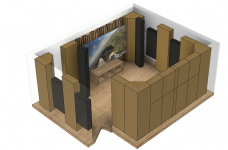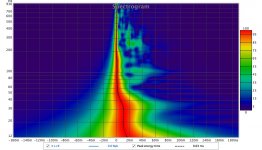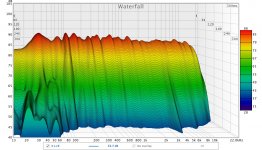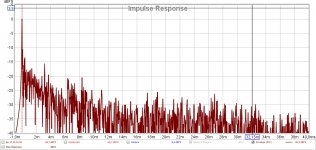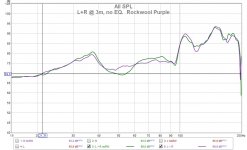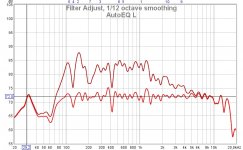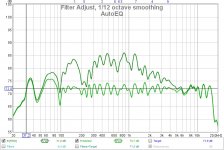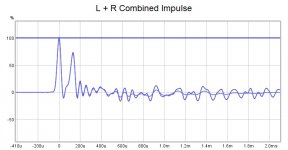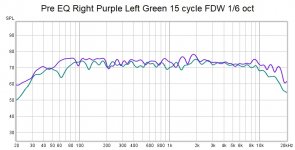No progress to show for yet, simply because I havent had time 
Had a visitor yesterday evening and we spent 3hrs in front of the arrays, listening and talking about line source and speaker / room integration. He was seriously impressed by the arrays and felt a strong "electrostat feeling" about their audible apperance/signature.
Right now I am playing with an Auto-EQ'd response and experimenting with Low shelf / High Shelf to even out the FR/SPL by ear. Havent measured it yet.
I have also added 6 more absorption panels (200mm thick) at the rear and have now a total of 12 (200mm) + 5 panels (75mm+50mm air).
I will during the winter work for a more LiveEnd/DeadEnd (LEDE) treatment configuration and slowly work the DSP/FIR-bit in during this time. Since room treatment affect response I wont consentrate my time solely on fine-EQ/FIR'ing other than getting to know the tools
Stay tuned
Had a visitor yesterday evening and we spent 3hrs in front of the arrays, listening and talking about line source and speaker / room integration. He was seriously impressed by the arrays and felt a strong "electrostat feeling" about their audible apperance/signature.
Right now I am playing with an Auto-EQ'd response and experimenting with Low shelf / High Shelf to even out the FR/SPL by ear. Havent measured it yet.
I have also added 6 more absorption panels (200mm thick) at the rear and have now a total of 12 (200mm) + 5 panels (75mm+50mm air).
I will during the winter work for a more LiveEnd/DeadEnd (LEDE) treatment configuration and slowly work the DSP/FIR-bit in during this time. Since room treatment affect response I wont consentrate my time solely on fine-EQ/FIR'ing other than getting to know the tools
Stay tuned
A write-up of the EQ/FIR process would be much appreciated, if you will have the time. (I have been following every thread here regarding arrays - starting with wesayso's of course).
Dont hold your breath as I have just now barely started to scratch the FIR-surface
No, mic remained in position between the two tests. Aimed directly between L+R speaker position.
Ok, good. Somehow it looked like the mic had slightly moved.
Have not managed to spend much listening to this yet, other than a quick 20min test run late last nite. Its very promising considering this is primarely a quick Auto-EQ'd correction set applied, with a little LowShelf(LS) boost and HighShelf(HS) drop to give me a reasonable house curve.
I will spend some time trying to improve the low end response, as per now the distortion increase (@ around 45-50hz) when SPL increase due to indiscerning left/right speaker LS applied here. Another tool to use is miniDSP FIR filters which I havent explored yet.
On a side note, the added damping in the rear have made a decent impact on impulse, very pleased with that :
:
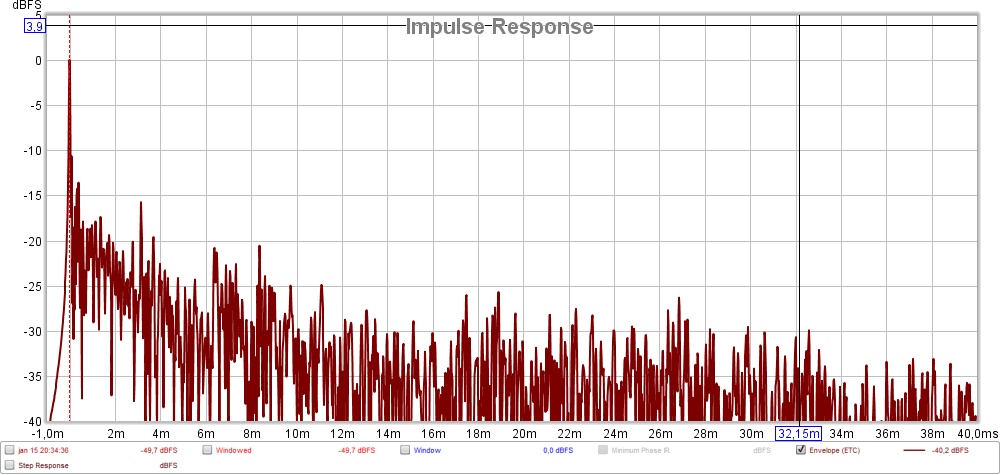
I will spend some time trying to improve the low end response, as per now the distortion increase (@ around 45-50hz) when SPL increase due to indiscerning left/right speaker LS applied here. Another tool to use is miniDSP FIR filters which I havent explored yet.
On a side note, the added damping in the rear have made a decent impact on impulse, very pleased with that
Attachments
Last had quite a fun few minutes with one of wesayso's "test albums" - Infected Mushroom Converting Vegetarians II 
At 90dB SPL (mean avg.) the first two track are quite entertaining
The 2nd track (Yamakas in Space) have a particular nice LF surge which provide a lovely transition between an audible and "ground" sensation. Not bad for 3,5"...
At 90dB SPL (mean avg.) the first two track are quite entertaining

The 2nd track (Yamakas in Space) have a particular nice LF surge which provide a lovely transition between an audible and "ground" sensation. Not bad for 3,5"...
I blame Wesayso as well for the exposure to Infected Mushroom. In terms of instrumental variety this may be the most eclectic music I’ve ever listened to, even more so than Pink Floyd, my all-time favorite. Even if I didn’t like it, it would be extremely useful for evaluating sound systems. I wonder if anyone plays it at the high end audio shows? Maybe John Darko could introduce it since it fits his preferred music genres.
My path to better sound, work in progress. This is more a work flow map than anything else:
Single sweetspot measurement, mic tilted 45deg up, aligned in center of R/L.
(FDW 15 width cycle)
REW Auto-EQ to 72dB flat response from 100-6000hz to get a flat measuring setup. (Curve tilt etc done later)
These are then saved as a coefficient file (.txt) which are imported into the Output PEQ slot on my miniDSP.
Single sweetspot measurement, mic tilted 45deg up, aligned in center of R/L.
(FDW 15 width cycle)
REW Auto-EQ to 72dB flat response from 100-6000hz to get a flat measuring setup. (Curve tilt etc done later)
These are then saved as a coefficient file (.txt) which are imported into the Output PEQ slot on my miniDSP.
Attachments
Last edited:
As seen the distortion drop in the 60-80hz range.
Funny side effect, the 3rd and 4th panel was taken down from the left wall and now appear as a spike in the IR!
Hi Halair, There is actually no change in distortion if you look at the underlying graph, what has changed is the noise floor in the measurement which is the blocky trace.
Omni mics change their frequency response quite a bit when you orient them off axis, it is hard to say exactly what effect the tilting up at 45 degrees will have, it is unlikely to make the measurement more accurate.
How to make a 90 degree calibration file
The above is a guide to making a 90 degree correction file. I used a single TC9 placed into a large cardboard baffle and measured at a close distance. It is important to get the capsule to occupy exactly the same position in space (as far as possible) between measurements for the best accuracy. There is an amount of messing around with a spreadsheet but I think it is worth the time and energy. I have made comparison measurements that I posted in my thread at some point so I know it works well. There is only a change above 1Khz and the main change happens around 10Khz but the output drops quite a bit so it needs calibrating to take account of it.
I'll have a look at your measurements later and see if I can make a filter for you
I downloaded the Manual for the 2x4HD, turns out that the it will only be able to use 1 x 2048 tap filter per channel, which is a lot less than the spec sheet implied. 10 bands of PEQ on input and output should help, but it does change what is possible.
To get remote functionality and volume control via IR you need to setup IR learning with a remote, page 48 in the manual. I don't recommend using the same apple remote as you use for the appletv as it will interfere. It seems to support most protocols so most old TV or media player remotes should work.
To get remote functionality and volume control via IR you need to setup IR learning with a remote, page 48 in the manual. I don't recommend using the same apple remote as you use for the appletv as it will interfere. It seems to support most protocols so most old TV or media player remotes should work.
This is what your L and Right Combined Impulse looks like, you can see the two peaks when zoomed in, this means that the mic is not in the exact centre position between the two, when you take another measurement, do the combined one first and move the mic until these peaks are one. No big deal for individual measurements but it is good to know where the exact centre position is, this makes quite a difference in stereo imaging in the sweet spot.
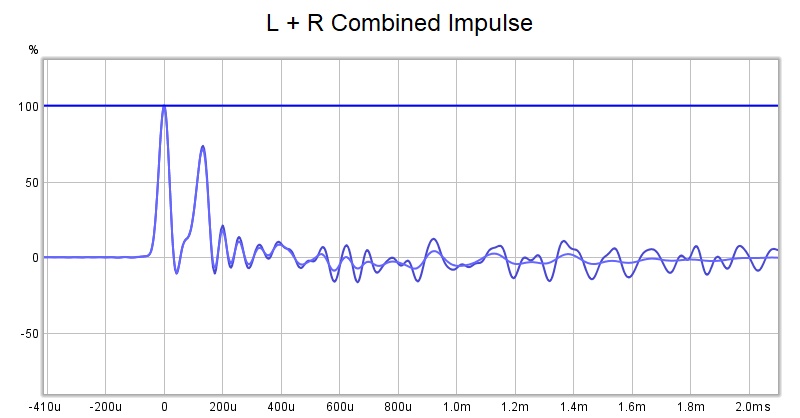
Attachments
My tool of referense is a 15band graphic analyzer, analog 
(Ashly MQX 2150 Dual 15)
I browsed the manual last nite online and configuring the remote should be easy enough. My old Marantz receiver's remote may be ideal for that use, the Apple remote have too few buttons to use reliably for the DSP functions.
Okay, so L+R combined first to establish a truly centered mic position, then individual measurements
Will also generate a 90deg cal-file asap.
(Ashly MQX 2150 Dual 15)
I browsed the manual last nite online and configuring the remote should be easy enough. My old Marantz receiver's remote may be ideal for that use, the Apple remote have too few buttons to use reliably for the DSP functions.
when you take another measurement, do the combined one first and move the mic until these peaks are one.
Okay, so L+R combined first to establish a truly centered mic position, then individual measurements
Will also generate a 90deg cal-file asap.
Last edited:
Might still be useful for tweaksMy tool of referense is a 15band graphic analyzer, analog
(Ashly MQX 2150 Dual 15)
YesOkay, so L+R combined first to establish a truly centered mic position, then individual measurements
I've got one channel of Pre EQ done, fingers crossed I can get you something to try soon.
I have attached some Biquad files to load into your MiniDSP as a pre EQ, there is a separate file for left and right. You should be able to load them by setting the EQ to advanced.
Take a new set of measurements with just these filters in place and nothing else. This will form a baseline for DRC processing. I'll carry on with virtual testing for now to see what happens with a 2048 tap filter.
This is what the responses should look like when viewed through a 15 cycle FDW and 1/6 oct smoothing if the EQ does what it's supposed to
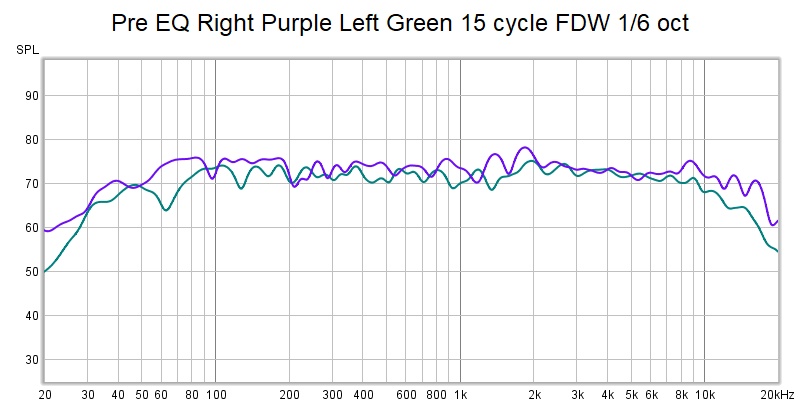
I have tried to save a few PEQ's for later use if needed so it's not as good as it could be. What High Pass filters can you set in the MiniDSP?
Take a new set of measurements with just these filters in place and nothing else. This will form a baseline for DRC processing. I'll carry on with virtual testing for now to see what happens with a 2048 tap filter.
This is what the responses should look like when viewed through a 15 cycle FDW and 1/6 oct smoothing if the EQ does what it's supposed to
I have tried to save a few PEQ's for later use if needed so it's not as good as it could be. What High Pass filters can you set in the MiniDSP?
Attachments
- Status
- This old topic is closed. If you want to reopen this topic, contact a moderator using the "Report Post" button.
- Home
- Loudspeakers
- Full Range
- HalAir Aeralis - Fullrange Line Array (Vifa TC9-18-08)
